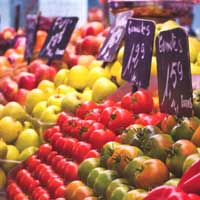
Martin Oliver provides insight into how retail giants stomp on small shop owners and farmers, and what consumers can do to help keep local businesses alive.
Of all countries in the world, Australia has the most concentrated supermarket sector, with Coles and Woolworths controlling about 80% of the market. The Big Two have been found to lower their prices when in competition with other supermarkets and independent retailers. Now, the German-owned Aldi chain has entered the picture and is making inroads, sacrificing choice in order to achieve low prices.
Â
Â
Paying less for goods may seem attractive, but do these huge corporations bring other benefits to local communities?
The United Kingdom’s New Economics Foundation (NEF) estimates that about 20% of the money spent in a chain remains in the local area, compared to up to 80% in the case of some local food outlets. In response, the NEF has launched its own awareness-raising site, Plugging the Leaks.
Greenhouse emissionsÂ
In addition to Australia’s near duopoly, other reasons for tracking down alternatives to supermarkets include shorter supply chains, and therefore the likelihood of lower greenhouse emissions.
The ugliness of the box-style constructions that house these major outlets is objectionable to a lot of people. There is also the big demand these building have for power and water. And when a new supermarket opens, it is common for locally-owned stores such as bakers, butchers, and fishmongers to go out of business.
One way to avoid supporting these mammoth businesses is to shop at a corner store. This is ideal for people with limited mobility, and the service is often more friendly and personal. On the downside, range is limited and prices are usually higher than in supermarkets. More fundamentally, many people no longer have such a store nearby.
Food re-localisation
When buying produce, the freshest option is a farmers’ market, where the food is in season, produce is more likely to be organic or “chemical-free”, and delivery kilometres minimal. At a regional level, this {quotes}. . .supports food re-localisation at a time when oil supplies are expected to peak soon{/quotes}.
Using your dollars at a farmers’ market supports smallholders, who might otherwise be unable to remain economically viable on their modest hectares. This may also help slow the trend towards bigger farms and more mechanisation. Farms selling to supermarkets might receive about 5-20% of the retail price, whereas selling their produce at a farmers’ market might yield between 40-80%.
Fewer car trips
Other ways to buy food without going to a supermarket include:Â
- Home deliveries, often involving organic produce. This is an excellent choice from a carbon footprint perspective, because deliveries result in fewer car trips to food retailers
- Buying from roadside food stalls, or Pick Your Own farms
- Growing your own, and giving away any excess
- Cultivating food in a community garden
- Gleaning, a movement that is big in the US, and involves gathering – with the landowner’s permission – food left after harvesting, or which would be left to rot under fruit trees
When buying non-food items, consider:
- Independent retailers
- Multi-level marketing, or network marketing. With payments going directly to the distributor, more money stays in the local economy
- Online shopping. However, while this removes the need for retail space, it may channel funds into the hands of corporate giants in a similar way to shopping in retail chains
- Buying secondhand, in places such as op shops
- Joining the international Freecycle network, where members give away and request unwanted items
Ultimately, there is no reason why the community itself should not be a major holder of local economic resources. But this does require a shared vision, good organisation, mutual trust, and cohesion. Although uncommon, cooperatively-owned stores are found in some small towns, including Esk in Queensland, Barossa in South Australia and York in Western Australia. Many small wholefood cooperatives that offer discount prices can be added to these.
Community autonomy
A group in Lismore has recently devised a model for local stores known as EcoMart. The plan is to encourage a network of community-owned shops, each selling local produce, goods and services. In addition to environmental sustainability, goals include strong ethics, more jobs, and community autonomy from big business.
Communities have discovered that one of the best tools for keeping money circulating locally is to create a note-based complementary currency. In the Massachusetts town of Great Barrington, with a population of about 7000, the BerkShares currency system has so far attracted 365 businesses.
The use of such currencies is a key concern of the Transition movement, which is working to achieve greater levels of community resilience. Two Transition communities in the UK, Totnes and Lewes, have already launched their own local notes and they are proving popular.
Challenging these moves towards breaking away from major chain retailers is a trend known as “local-washing” that is common in the US, and could arrive here. Like the better-known greenwashing, this is an attempt by an increasing number of large corporations to tap into the “local” market through making claims that are sometimes misleading. HSBC refers to itself as “the world’s local bank”, and Starbucks has just opened a “local” café in Los Angeles featuring alcohol, live music and poetry readings.
ResourcesPlugging the Leaks www.pluggingtheleaks.org EcoMart www.ecomartaustralia.org Freecycle www.freecycle.org/group/AU Transition Towns www.transitiontowns.org |
Â
Â










































